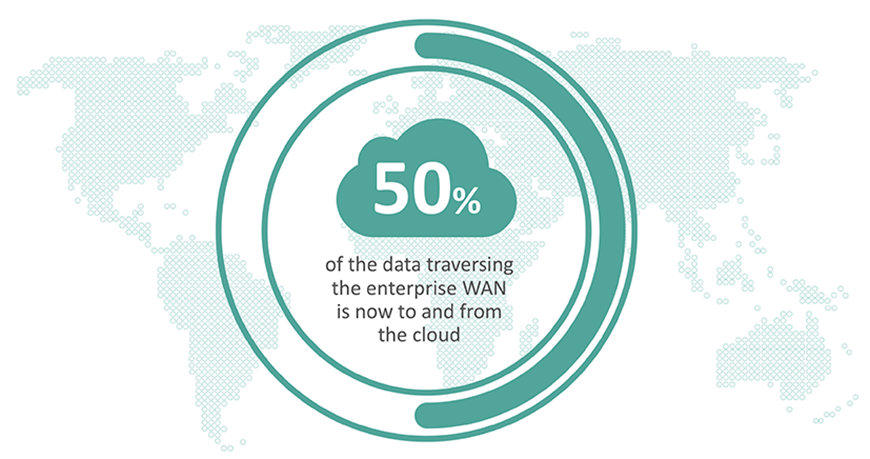How SD-WAN as a Service Overcomes MPLS Limitations

Although MPLS has served the enterprise well for years, it can no longer adequately meet the demands of global enterprises. Over 50% of enterprise WAN traffic now involves cloud. MPLS was designed before the cloud era, for point-to-point connections. But there are also other limitations:
- No single provider can deliver MPLS end-to-end around the world. Global MPLS networks are cobbled together using a range of service providers. This leads to service problems when issues arise, and complicates the ability to provide adequate network redundancy.
- MPLS is a dynamic, shared medium. While MPLS is traditionally viewed as a private network service, it is actually a shared medium that does carry some risk. Security conscious buyers will, instead, gravitate toward dedicated bandwidth to close that loophole.
- Not all “private networks” are secure. If no single provider owns the MPLS network around the world, and the traffic is simply differentiated with an MPLS label, how hard is it to SPAN a port and sniff the traffic? Also, if you have to break out cloud traffic over the Internet, you open up new attack vectors.
- MPLS wasn’t designed for the speed of business today. Change orders can take weeks, and new installations can take months. Companies today must be able to add locations in days and make service changes on the fly.
- Costs are lopsided. MPLS pricing is from a bygone era when bandwidth needs were a fraction of what they are today, so the premium pricing was tolerated. Bandwidth requirements are growing at a 26% compound annual growth rate, by some accounts, and MPLS is simply too expensive to use for everything.
The shortcomings of MPLS have forced enterprises to consider alternatives which only address pieces of the problem. The planning, procurement, and management of the network is still left in the hands of the enterprise, and complicate resolution efforts.
Traditional Point Solutions Solve the Problem

Let’s examine some of the standard point solutions customers naturally gravitate to when they find MPLS can no longer meet their needs. Each provides a fix to a set of problems vs. the greater problem as a whole:
- This is the first option most organizations consider when bandwidth needs increase or fast deployment is an essential requirement. With the Internet, you gain faster implementation, but lacks stability and cannot offer SLAs across the middle mile or over long distances. If one of the layers supporting your applications and services is the Internet, end-to-end stability, packet loss recovery algorithms and protocol enhancements are absolute necessities, not options.
- WAN Optimization. Whether you are trying to dress up MPLS to meet some of the new requirements or using the best effort, public Internet to supplement MPLS, you’ll need additional optimization tools along the WAN routes if you want to try to deliver a consistent experience regardless of where users are located. That will involve significant CapEx investment and leave you with still more network resources to manage. Even then, it might not adequately address the performance issue, especially for international scenarios.
- IPsec is a must, not just at the edge but also in the core or the middle mile. However, you’ll have to compliment that by deploying and managing a host of network security tools to ensure no one can find their way into the network through the many WAN tendrils.
- SD-WAN. While SD-WAN makes it possible to use the Internet to supplement MPLS and set policies that spell out how traffic is to be handled, all the concerns outlined above apply.
If you only have a few locations and they are in the same region and you don’t use a lot of cloud services, an Internet-based SD-WAN might be the answer you’re looking for. But if you are a larger enterprise with geographically-distributed locations using or considering many cloud services, the do it yourself SD-WAN kits will leaving you wanting more…not to mention the integration headaches. But you do have a choice: you could construct and get stuck or consume and scale rapidly.
So What Makes a Good WAN?
There needs to be a better way to address all of these issues. The ideal WAN should:
- Optimize TCP – this has a triple effect on your flows. Packet payload sizes are bigger, packets closer together, throughput ramps up much faster, and your first byte transfers faster. For any data application, TCP optimization is a must
- Address packet loss recovery using a full set of SD-WAN algorithms, not just 1 or 2
- Provide Optimal Agility to facilitate moves, add or change sites, quick disconnection
- Deliver built-in redundancy at all levels in the infrastructure
- Optimize bandwidth and thereby optimize the dollars spent on the network
- Provide 24x7x365 support
- Deliver detailed visibility through a portal, not just in/out bandwidth, but application level usage, performance metrics and stats
- Provide one throat to choke for all of these services to avoid finger pointing
All of which points you toward an SD-WAN delivered as a service you consume instead of building yourself. Instead of point solutions that address different pieces of the problem, SD-WAN as a Service relieves you of the job of figuring out how to: accommodate rampant bandwidth growth; support corporate digital transformation initiatives; and the migration to cloud. And it does all of that while simplifying the network and freeing up IT resources to focus on opportunities to grow the business.
The time for SD-WAN is now, and the only SD-WAN to address your evolving needs is one delivered as a service. To learn more download the latest report from Doyle Research, or view download our latest white paper, SD-WAN vs. MPLS: Key Considerations for Your Global Enterprise Network.

